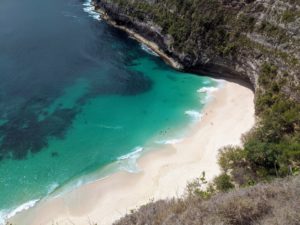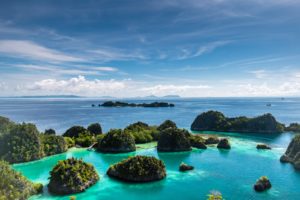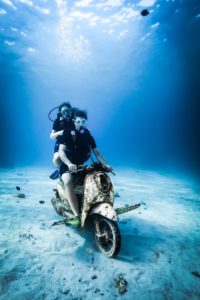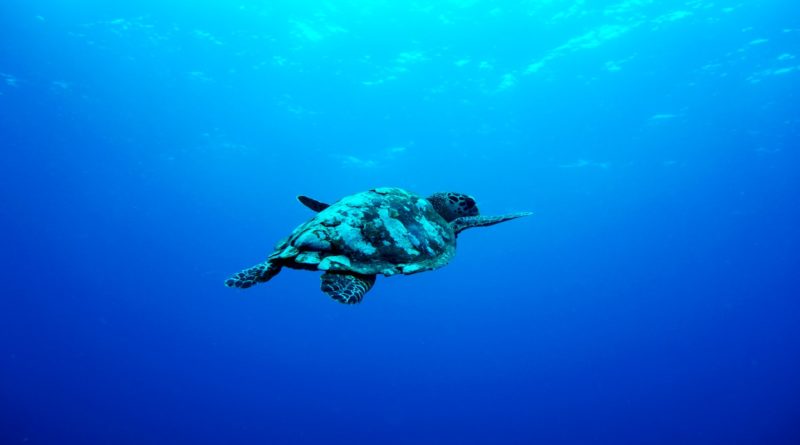Indonesia, Every Diver’s Disneyland
Whether its culturally, ecologically or geographically, Indonesia is THE epitome of diversity. A massive amount of diverse animals (including many endemic ones) call Indonesia their home. In fact, this is precisely the reason it’s one of only 17 Megadiverse countries on our planet.
 Many of these curious, flamboyant or freaky inhabitants lurk beneath the surface of the deep blue. You may encounter up to 3000 different species of fish within the archipelago (twice as many as the Great Barrier Reef!). While many of the volcanoes scattered across Indonesia’s 17,000 islands create life-threatening conditions for the locals, they are part of the reason why Indonesia is part of the coral triangle. You see, these nutrient-rich volcanic sediments are spread around the straits by oceanic currents. This nourishes the reefs with minerals and thus enables its inhabitants to flourish carelessly.
Many of these curious, flamboyant or freaky inhabitants lurk beneath the surface of the deep blue. You may encounter up to 3000 different species of fish within the archipelago (twice as many as the Great Barrier Reef!). While many of the volcanoes scattered across Indonesia’s 17,000 islands create life-threatening conditions for the locals, they are part of the reason why Indonesia is part of the coral triangle. You see, these nutrient-rich volcanic sediments are spread around the straits by oceanic currents. This nourishes the reefs with minerals and thus enables its inhabitants to flourish carelessly.
As such, Indonesia is a real paradise for divers. While mentioning volcanoes and oceanic currents might have scared off the less-adventurous or less experienced diver, it should be noted: Indonesia has places for every kind of diver whether it’s a family looking for casual fun snorkeling around shallow reefs in the Java sea, macro photographers that fell in love with those colorful nudibranchs, or veteran divers looking to fix their next adrenaline rush in unknown terrain.
Bali – Lighthearted Family Fun
It is no secret that Bali is a family-friendly destination, where one can have an exotic vacation without giving up the comfort they’re used to from home. Compared to the other three goals mentioned here, Bali does not boast an immediate Malaria threat. As scuba diving kids are a rare occurrence, parents will be glad to know that families can have affordable, pristine snorkeling experiences all around Bali and its neighboring islands.
 Nusa Penida is a secluded island, that’s a short speedboat ride away from the south of the island. It boasts many unique dive sites that offer more than the average hard coral reef. At crystal bay, more experienced divers have a chance to find a rare, gentle giant cruising around between August and October. The Mola Mola (also known as sunfish) is a sporadic occurrence worldwide. If you happen to be unlucky, there are still other spectacular species such as frogfish, leopard sharks and scorpionfish to keep you occupied. For casual divers or snorkeling families, Manta Point might be one of the most spectacular dive sites between March and June. That’s the season, where manta rays scour along the cliffs. Diving along manta rays is a unique experience, that should be on everyone’s bucket list. Parents: don’t be worried! There are no currents, and manta rays are gentle, well-spirited creatures that couldn’t care less about your kids.
Nusa Penida is a secluded island, that’s a short speedboat ride away from the south of the island. It boasts many unique dive sites that offer more than the average hard coral reef. At crystal bay, more experienced divers have a chance to find a rare, gentle giant cruising around between August and October. The Mola Mola (also known as sunfish) is a sporadic occurrence worldwide. If you happen to be unlucky, there are still other spectacular species such as frogfish, leopard sharks and scorpionfish to keep you occupied. For casual divers or snorkeling families, Manta Point might be one of the most spectacular dive sites between March and June. That’s the season, where manta rays scour along the cliffs. Diving along manta rays is a unique experience, that should be on everyone’s bucket list. Parents: don’t be worried! There are no currents, and manta rays are gentle, well-spirited creatures that couldn’t care less about your kids.
The Blue Lagoon in Padangbai is another casual dive spot that is very suitable for beginners. It is also one of Bali’s most budget-friendly dive sites. You can hire a boat to take you out for a 2 hour trip for around 20$. It is also conveniently located en route to numerous temples and indigenous villages, which are popular day tour attraction. If you happen to go in the area, make sure you let your driver know in advance, that you want to stop in Padang bai for a while.
Lembeh Strait – The Mecca for Muck divers
 Lembeh Strait is described by so many as a ‘world-class muck diving destination.’ Once you’ve been there you will probably agree that it’s hard to argue. The Lembeh Strait is a 15km long waterway located in the northern part of Sulawesi, which is the 9th largest island in the world. Very few people know about it. Besides diving, The area around Manado has a lot to offer. Renting a scooter for a round trip to check out not only Lembeh but also Tangkoko National Park and the vertical reefs of Bunaken is undoubtedly worthwhile. Getting lost in the windy mountain roads or busting your tire in one of the many potholes may turn out to be a memorable experience due to the incredibly welcoming, helpful locals. Additionally, the locals here are mostly Christian, so chugging down a Sundowner beer is entirely possible in contrast to other parts of Indonesia. The pilgrimage to this remote region is justified by the photogenic and freaky inhabitants, that can be found at over 90 recognized dive sites.
Lembeh Strait is described by so many as a ‘world-class muck diving destination.’ Once you’ve been there you will probably agree that it’s hard to argue. The Lembeh Strait is a 15km long waterway located in the northern part of Sulawesi, which is the 9th largest island in the world. Very few people know about it. Besides diving, The area around Manado has a lot to offer. Renting a scooter for a round trip to check out not only Lembeh but also Tangkoko National Park and the vertical reefs of Bunaken is undoubtedly worthwhile. Getting lost in the windy mountain roads or busting your tire in one of the many potholes may turn out to be a memorable experience due to the incredibly welcoming, helpful locals. Additionally, the locals here are mostly Christian, so chugging down a Sundowner beer is entirely possible in contrast to other parts of Indonesia. The pilgrimage to this remote region is justified by the photogenic and freaky inhabitants, that can be found at over 90 recognized dive sites.
Raja Ampat – The Ultimate Off-Grid Experience
 If you’re a veteran diver and feel like you’ve seen it all, you should consider visiting Raja Ampat. It is located in western Papua and is considered incredibly exotic, even by Indonesian standards! This cluster of islands is home to many diving resorts, that are dotted along the shores. This means a private jetty shuttle and secluded beaches are usually a given here. Unfortunately, the great isolation also makes it by far the most expensive destination mentioned here.
If you’re a veteran diver and feel like you’ve seen it all, you should consider visiting Raja Ampat. It is located in western Papua and is considered incredibly exotic, even by Indonesian standards! This cluster of islands is home to many diving resorts, that are dotted along the shores. This means a private jetty shuttle and secluded beaches are usually a given here. Unfortunately, the great isolation also makes it by far the most expensive destination mentioned here.
Melissa’s Garden is a massive coral garden reef and home to wobbegongs, reef sharks, ghost pipefish, pygmy seahorses and nudibranchs in all possible colors. There are no strong currents, and the site is considered ideal for all levels of divers.
Fun fact: At the dive site known as Cape Kri, Dr. Gerry Allen encountered 374 species in a one-tank dive. A world record. There is a current here, which is being utilized by large schools of barracudas, trevallies and snappers. The reef is around 40 meters deep, and the very bottom is marked by an old ship anchor. It is also considered a great dive for advanced macro divers.
Flores – Powerful currents and intimidating creatures
While Flores is mainly famous for the hobbit human (homo floresiensis) and the fierce, venomous Komodo dragon, it also boasts many surprises in its reefs, such as Mantas, Whalesharks, Black-Tip Sharks and much more. The dive sites here are so spectacular that many liveaboards arrive here from Bali. The unpredictably strong currents here mean you should be an advanced open water diver at the very least for most dive sites found here. If you plan to go here, you should hurry up if you’re on a budget, as officials hinted on increasing the entrance fee to Komodo National Park from 10$ per visitor to 500$! You might as well do your advanced open water license (which is less than 500$ in Indonesia), so you can enjoy the dive sites asap.
The Yellow Wall of Texas is a vertical reef located near the southern tip of the infamous Rinca island. Pairs of colorful butterflyfish tend to scour the ocean floors for crustacean prey. The face of the reef is also home to what many consider the most beautiful fish in the ocean, the vibrant clown triggerfish.
Personal Insurance and Scuba Diving
 Scuba diving in Indonesia is a fun and adventurous sport. Diving takes participants worldwide to explore interesting underwater destinations. In developing travel plans, divers often focus on important things like passports, equipment, gear, licenses, and many times travel insurance. The last thing most divers think about is having an accident while exploring a reef underwater. Unfortunately, though, travel insurance does not cover many of the risks and hazards associated with scuba diving. So, what insurance coverages should divers bind prior to setting sail on a diving excursion? Below we will look at the necessary coverages as well as considerations based on the type of trip on the horizon.
Scuba diving in Indonesia is a fun and adventurous sport. Diving takes participants worldwide to explore interesting underwater destinations. In developing travel plans, divers often focus on important things like passports, equipment, gear, licenses, and many times travel insurance. The last thing most divers think about is having an accident while exploring a reef underwater. Unfortunately, though, travel insurance does not cover many of the risks and hazards associated with scuba diving. So, what insurance coverages should divers bind prior to setting sail on a diving excursion? Below we will look at the necessary coverages as well as considerations based on the type of trip on the horizon.
Travel Insurance Limitations
As mentioned above, travel insurance is a good thing and you should buy it prior to going on a trip; however, you need to be fully aware of its limitations. A typical travel insurance policy will compensate you for flight and travel problems, illness while abroad, or basic emergencies that may occur. This policy will have very limited coverage and usually excludes coverage for accidents associated with risky activities such as scuba diving, skiing, and sky diving.
Dive Insurance Coverage
In contrast to the limited coverage offered in a travel insurance policy, a dive insurance policy tailors specifically to risks associated with scuba diving. For example, this type of policy provides coverage for the cost of recompression therapy and hospital care needed because of a diving accident. This policy covers search and rescue operation costs and replacing equipment damaged or lost due to an emergency. Note that scuba divers going on a trip for vacation have no need for third party liability diving insurance, which is necessary for professional divers leading excursions. Below are three important factors to consider when purchasing a dive insurance policy.
Some providers are:
Dive Insurance Considerations
 Limits on Recompression coverage – the cost for recompression can vary greatly depending on the location. Given the necessity of ample recompression in the event of sickness, divers must make sure the policy limit is either unlimited or very high as it relates to this portion of the dive insurance coverage.
Limits on Recompression coverage – the cost for recompression can vary greatly depending on the location. Given the necessity of ample recompression in the event of sickness, divers must make sure the policy limit is either unlimited or very high as it relates to this portion of the dive insurance coverage.
Restrictions on depth/type or equipment – many dive insurance policies have restrictions or exclusions based on the certification of the diver. If the diver has an accident and ends up at a depth outside of his or her certification, then the exclusion on the policy could void coverage. Divers must carefully review the policy to make sure the coverage is broad enough to allow for these sort of unforeseen circumstances.
Time Restrictions – many dive insurance policies provide coverage for trips that occur over a specific number of days, i.e. 60 or 90 days. However, for coverage to continue after the time restriction, the diver must return home prior to beginning another trip. Divers must understand this restriction to make sure the policy works given the trip schedule.
Life Insurance Coverage
Finally, depending on a diver’s family situation, he or she should consider a life insurance policy. If others depend on your income, then often this policy is a wise investment. Divers need to review the policy language though to make sure that scuba diving is not an excluded activity under the policy.
Do not let a lack of insurance coverage ruin your next diving vacation. By asking the right questions, reviewing your policy and following the above tips, divers can be confident that if an accident occurs, they will have adequate insurance coverage.
Also you should check if you car insurance is valid if you take your car abroad. To learn more check sites like Bilforsikring and this guide from Investopedia.




